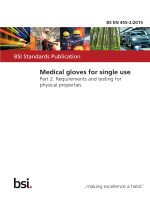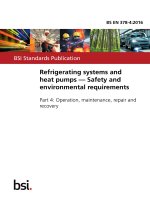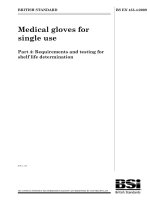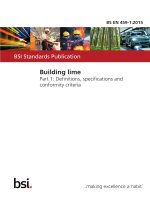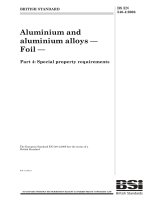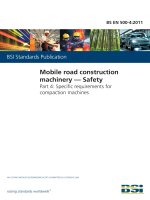Bsi bs en 13032 4 2015
Bạn đang xem bản rút gọn của tài liệu. Xem và tải ngay bản đầy đủ của tài liệu tại đây (1.53 MB, 70 trang )
BS EN 13032-4:2015
BSI Standards Publication
Light and lighting — Light and
lighting — Measurement and
presentation of photometric
data of lamps and luminaires
Part 4: LED lamps, modules and luminaires
BS EN 13032-4:2015 BRITISH STANDARD
National foreword
This British Standard is the UK implementation of EN 13032-4:2015.
The UK participation in its preparation was entrusted to Technical
Committee EL/1, Light and lighting applications.
A list of organizations represented on this committee can be
obtained on request to its secretary.
This publication does not purport to include all the necessary
provisions of a contract. Users are responsible for its correct
application.
© The British Standards Institution 2015.
Published by BSI Standards Limited 2015
ISBN 978 0 580 82825 6
ICS 17.180.20; 29.140.99
Compliance with a British Standard cannot confer immunity from
legal obligations.
This British Standard was published under the authority of the
Standards Policy and Strategy Committee on 30 June 2015.
Amendments/corrigenda issued since publication
Date Text affected
EUROPEAN STANDARD BS EN 13032-4:2015
NORME EUROPÉENNE
EUROPÄISCHE NORM EN 13032-4
ICS 17.180.20; 29.140.99 June 2015
English Version
Light and lighting - Light and lighting - Measurement and
presentation of photometric data of lamps and luminaires - Part
4: LED lamps, modules and luminaires
Lumière et éclairage - Mesure et présentation des données Licht und Beleuchtung - Messung und Darstellung
photométriques des lampes et des luminaires - Partie 4: photometrischer Daten von Lampen und Leuchten - Teil 4:
Lampes, modules et luminaires LED LED-Lampen, -Module und -Leuchten
This European Standard was approved by CEN on 19 March 2015.
CEN members are bound to comply with the CEN/CENELEC Internal Regulations which stipulate the conditions for giving this European
Standard the status of a national standard without any alteration. Up-to-date lists and bibliographical references concerning such national
standards may be obtained on application to the CEN-CENELEC Management Centre or to any CEN member.
This European Standard exists in three official versions (English, French, German). A version in any other language made by translation
under the responsibility of a CEN member into its own language and notified to the CEN-CENELEC Management Centre has the same
status as the official versions.
CEN members are the national standards bodies of Austria, Belgium, Bulgaria, Croatia, Cyprus, Czech Republic, Denmark, Estonia,
Finland, Former Yugoslav Republic of Macedonia, France, Germany, Greece, Hungary, Iceland, Ireland, Italy, Latvia, Lithuania,
Luxembourg, Malta, Netherlands, Norway, Poland, Portugal, Romania, Slovakia, Slovenia, Spain, Sweden, Switzerland, Turkey and United
Kingdom.
EUROPEAN COMMITTEE FOR STANDARDIZATION
COMITÉ EUROPÉEN DE NORMALISATION
EUROPÄISCHES KOMITEE FÜR NORMUNG
CEN-CENELEC Management Centre: Avenue Marnix 17, B-1000 Brussels
© 2015 CEN All rights of exploitation in any form and by any means reserved Ref. No. EN 13032-4:2015 E
worldwide for CEN national Members.
BS EN 13032-4:2015
EN 13032-4:2015 (E)
Contents Page
Foreword ..............................................................................................................................................................5
Introduction .........................................................................................................................................................6
1 Scope ......................................................................................................................................................7
2 Normative references ............................................................................................................................7
3 Terms and definitions ...........................................................................................................................8
4 Laboratory requirements ................................................................................................................... 17
4.1 General................................................................................................................................................. 17
4.1.1 Standard Test Conditions .................................................................................................................. 17
4.1.2 Tolerance Interval ............................................................................................................................... 18
4.2 Laboratory and Environmental Conditions...................................................................................... 18
4.2.1 Test Room ........................................................................................................................................... 18
4.2.2 Ambient Temperature......................................................................................................................... 18
4.2.3 Surface Temperature (tp-Point Temperature)................................................................................... 19
Air Movement ...................................................................................................................................... 19
4.2.4 Operating Position.............................................................................................................................. 20
4.2.5 Electrical Test Conditions and Electrical Equipment ..................................................................... 20
4.3 Test Voltage and Test Current........................................................................................................... 20
4.3.1 Electrical Measurements.................................................................................................................... 21
4.3.2 Electrical Power Supply ..................................................................................................................... 21
4.3.3 Stabilization before Measurement .................................................................................................... 23
4.4 General................................................................................................................................................. 23
4.4.1 LED Lamps and LED Luminaires ...................................................................................................... 23
4.4.2 LED Modules ....................................................................................................................................... 23
4.4.3 Photometric and Colorimetric Measurement Instruments ............................................................. 23
4.5 General................................................................................................................................................. 23
4.5.1 Spectral Responsivity Requirements for Photometers .................................................................. 24
4.5.2 Integrating Sphere (all Types) ........................................................................................................... 25
4.5.3 Goniophotometer (all Types) ............................................................................................................. 27
4.5.4 Luminance Meters .............................................................................................................................. 29
4.5.5
5 Preparation, mounting and operating conditions ........................................................................... 29
5.1 Ageing .................................................................................................................................................. 29
5.2 Test device .......................................................................................................................................... 29
5.3 Mounting.............................................................................................................................................. 29
5.3.1 Operating orientation ......................................................................................................................... 29
5.3.2 Coordinate system.............................................................................................................................. 30
5.3.3 Photometric Centre............................................................................................................................. 30
5.4 Operating conditions of the LED devices ........................................................................................ 30
5.4.1 General................................................................................................................................................. 30
5.4.2 LED lamps ........................................................................................................................................... 31
5.4.3 LED modules ....................................................................................................................................... 31
5.4.4 LED luminaires.................................................................................................................................... 31
6 Measurement of photometric quantities .......................................................................................... 31
6.1 General................................................................................................................................................. 31
6.2 Measurement of total luminous flux ................................................................................................. 31
6.3 Partial Luminous Flux ........................................................................................................................ 32
6.4 Luminous efficacy .............................................................................................................................. 33
6.5 Luminous intensity distribution and data presentation ................................................................. 34
6.5.1 General................................................................................................................................................. 34
2
BS EN 13032-4:2015
EN 13032-4:2015 (E)
6.5.2 LED-lamps and LED-modules ............................................................................................................ 34
6.5.3 LED-luminaires .................................................................................................................................... 34
6.6 Centre beam intensity and beam angles........................................................................................... 34
6.7 Luminance Measurements ................................................................................................................. 35
7 Measurement of colour quantities.....................................................................................................35
7.1 Colorimetric Measurements ............................................................................................................... 35
7.1.1 General aspects ................................................................................................................................... 35
7.1.2 Correlated Colour Temperature (white LED light sources).............................................................36
7.1.3 Colour Rendering Indices (white LED light sources) ...................................................................... 37
7.1.4 Angular Colour Uniformity ................................................................................................................. 37
8 Measurement Uncertainties ............................................................................................................... 37
8.1 General ................................................................................................................................................. 37
8.2 Guidance for Measurement uncertainty budgets ............................................................................ 38
8.2.1 Common parameters to all measurements ...................................................................................... 38
8.2.2 Luminous flux ...................................................................................................................................... 38
8.2.3 Luminous intensity and luminance ................................................................................................... 40
8.2.4 Colour quantities ................................................................................................................................. 40
8.2.5 Electrical power ................................................................................................................................... 40
8.2.6 Luminous efficacy ............................................................................................................................... 40
9 Presentation of test results ................................................................................................................ 41
9.1 Test report ............................................................................................................................................ 41
9.1.1 Introduction.......................................................................................................................................... 41
9.1.2 General information ............................................................................................................................ 41
9.1.3 Information on the device(s) under test ............................................................................................ 41
9.1.4 Information on the test procedure ..................................................................................................... 42
9.1.5 Photometric and/or colorimetric data ............................................................................................... 42
Annex A (informative) Guidance on the Application of this standard ....................................................... 43
A.1 General ................................................................................................................................................. 43
A.2 Tolerance Interval ................................................................................................................................ 44
Annex B (informative) Stray light — Screening against stray light in a goniophotometer .....................45
Annex C (informative) Practical laboratory conditions ............................................................................... 46
C.1 Correction factors ............................................................................................................................... 46
C.1.1 Measurement correction factors........................................................................................................46
C.1.2 Service conversion factors ................................................................................................................ 46
C.2 Sensitivity coefficients........................................................................................................................ 46
C.3 Typical Sensitivity coefficients and tolerance intervals..................................................................47
C.3.1 General ................................................................................................................................................. 47
C.3.2 Ambient temperature .......................................................................................................................... 47
C.3.3 Measurement of a LED module at Performance Temperature .......................................................47
C.3.4 Air movement.......................................................................................................................................50
C.3.5 Test voltage..........................................................................................................................................50
C.3.6 Spectral mismatch of photometer ..................................................................................................... 51
C.3.7 Model for Luminous Intensity Distribution ....................................................................................... 52
Annex D (informative) Guidance on calculating measurement uncertainties .......................................... 54
D.1 General ................................................................................................................................................. 54
3
BS EN 13032-4:2015
EN 13032-4:2015 (E)
D.2 Uncertainty budget ............................................................................................................................. 54
D.3 Example of measurement uncertainties........................................................................................... 55
Annex E (informative) Guidance for determining rated values of photometric quantities of LED
luminaires ............................................................................................................................................ 61
E.1 Introduction ......................................................................................................................................... 61
E.2 Rating and tolerance of LED-luminaire data .................................................................................... 61
Bibliography ..................................................................................................................................................... 64
4
BS EN 13032-4:2015
EN 13032-4:2015 (E)
Foreword
This document (EN 13032-4:2015) has been prepared by Technical Committee CEN/TC 169 “Light and
Lighting”, the secretariat of which is held by DIN.
This European Standard shall be given the status of a national standard, either by publication of an identical
text or by endorsement, at the latest by December 2015, and conflicting national standards shall be withdrawn
at the latest by December 2015.
Attention is drawn to the possibility that some of the elements of this document may be the subject of patent
rights. CEN [and/or CENELEC] shall not be held responsible for identifying any or all such patent rights.
This standard was developed in collaboration with CIE TC2.71, which developed CIE S 025, to produce two
technically-harmonized standards at CEN and CIE level.
Acknowledgement is given to CIE for their support in the preparation of this standard.
According to the CEN/CENELEC Internal Regulations, the national standards organisations of the following
countries are bound to implement this European Standard: Austria, Belgium, Bulgaria, Croatia, Cyprus, Czech
Republic, Denmark, Estonia, Finland, Former Yugoslav Republic of Macedonia, France, Germany, Greece,
Hungary, Iceland, Ireland, Italy, Latvia, Lithuania, Luxembourg, Malta, Netherlands, Norway, Poland, Portugal,
Romania, Slovakia, Slovenia, Spain, Sweden, Switzerland, Turkey and the United Kingdom.
5
BS EN 13032-4:2015
EN 13032-4:2015 (E)
Introduction
This standard provides requirements to perform reproducible photometric and colorimetric measurements on
LED lamps, LED modules and LED luminaires (LED devices). It also provides advice for the reporting of the
data.
The availability of reliable and accurate photometric data for LED devices is a basic requirement for designing
good lighting systems and evaluating performance of products. By obtaining these data through
measurements in specific normalized measuring conditions the consistency of the data should be ensured
between different laboratories (within the limits of the declared measurement uncertainty) and comparison of
different products on the same basis is possible.
This standard aims in particular to cover measurement methods for testing the compliance of LED devices
with the photometric and colorimetric requirements of LED performance standards (see Clause 2) issued by
IEC/TC 34/CLC/TC 34 “Lamps and related equipment” and/or relevant European regulations.
LED devices offer a large variety of configurations in respect to geometry and/or colour. For each
configuration the photometric and colorimetric performances are considered individually.
6
BS EN 13032-4:2015
EN 13032-4:2015 (E)
1 Scope
This European Standard specifies the requirements for measurement of electrical, photometric, and
colorimetric quantities of LED lamps, LED modules and LED luminaires, for operation with AC or DC supply
voltages, possibly with associated LED control gear. LED light engines are assimilated to LED modules and
handled accordingly. Photometric and colorimetric quantities covered in this standard include total luminous
flux, luminous efficacy, partial luminous flux, luminous intensity distribution, centre-beam intensity, luminance
and luminance distribution, chromaticity coordinates, correlated colour temperature (CCT), colour rendering
index (CRI), and angular colour uniformity.
This European Standard does not cover LED packages and products based on OLEDs (organic LEDs).
2 Normative references
The following documents, in whole or in part, are normatively referenced in this document and are
indispensable for its application. For dated references, only the edition cited applies. For undated references,
the latest edition of the referenced document (including any amendments) applies.
EN ISO 11664-1:2011, Colorimetry - Part 1: CIE standard colorimetric observers (ISO 11664-1:2007)
EN ISO 11664-2:2011, Colorimetry - Part 2: CIE standard illuminants (ISO 11664-2:2007)
EN ISO 11664-3:2013, Colorimetry - Part 3: CIE tristimulus values (ISO 11664-3:2012)
EN 12665, Light and lighting - Basic terms and criteria for specifying lighting requirements
EN 13032-1:2004+A1:2012, Light and lighting - Measurement and presentation of photometric data of lamps
and luminaires - Part 1: Measurement and file format
EN 61341:2011, Method of measurement of centre beam intensity and beam angle(s) of reflector lamps
(IEC/TR 61341:2010)
EN 62504:2014. General lighting -Light emitting diode products and related equipment-Terms and definitions
(IEC 62504:2014)
prEN 62717:2014, LED modules for general lighting - Performance requirements (IEC 62717:2014)
ISO/IEC Guide 98-3:2008, Uncertainty of measurement — Part 3: Guide to the expression of uncertainty in
measurement (GUM:1995)
ISO/IEC Guide 98-4:2012, Uncertainty of measurement — Part 4: Role of measurement uncertainty in
conformity assessment
ISO/IEC Guide 99:2007, International vocabulary of metrology — Basic and general concepts and associated
terms (VIM)
CIE/DIS 024/E:2013, Light Emitting Diodes (LEDs) and LED Assemblies – Terms and Definitions
CIE 13.3, Method of Measuring and Specifying Colour Rendering of Light Sources
CIE 15, Colorimetry
CIE 84:1989, Measurement of Luminous Flux
CIE 198:2011, Determination of Measurement Uncertainties in Photometry
7
BS EN 13032-4:2015
EN 13032-4:2015 (E)
CIE 198:2011-SP1, Determination of Measurement Uncertainties in Photometry – Supplement 1: Modules and
Examples for the Determination of Measurement Uncertainties
3 Terms and definitions
For the purposes of this document, the terms and definitions given in EN 12665, EN 13032-1 and the following
apply.
3.1
electric light source
primary light source that transforms electrical energy into optical radiation
[SOURCE: CIE/DIS 024/E:2013, 3.3]
3.2
light-emitting diode
LED
solid state device embodying a p-n junction, emitting incoherent optical radiation when excited by an electric
current
Note 1 to entry: This definition is independent from the existence of enclosure(s) and of terminals.
Note 2 to entry: The output is a function of its physical construction, material used and exciting current. The optical
emission may be in the ultraviolet, visible, or infrared wavelength regions.
Note 3 to entry: “LED” term represents the LED die (or chip) or LED package. It is also used as a generic term
representing the technology.
Note 4 to entry: “LED” term should not be used for reporting product performance (like luminous flux, colour rendering,
lifetime…) instead use for example “luminous flux of the LED module”.
[SOURCE: EN 62504:2014, 3.24]
3.3
LED package
single electrical component encapsulating principally one or more LED dies, possibly including optical
elements and thermal, mechanical, and electrical interfaces
Note 1 to entry: The component does not include the control unit of the control gear, does not include a cap, and is not
connected directly to the supply voltage.
Note 2 to entry: A LED package is a discrete component and part of the LED module or LED lamp.
[SOURCE: EN 62504:2014, 3.20]
3.4
LED light source
electric light source based on LED technology
Note 1 to entry: A luminaire may include LED light sources but is not considered itself as a light source.
Note 2 to entry: LED light source(s) for a LED luminaire represent(s) one or more LED lamp(s) or LED module(s).
[SOURCE: EN 62504:2014, 3.16]
8
BS EN 13032-4:2015
EN 13032-4:2015 (E)
3.5
LED lamp
LED light source provided with (a) cap(s) incorporating one or more LED module(s) and possibly including one
or more of the following: electrical, optical, mechanical, and thermal components, interfaces and control gear
Note 1 to entry: A LED lamp may be integrated (LEDi lamp) or semi-integrated (LEDsi lamp) or non-integrated
(LEDni lamp).
Note 2 to entry: Single and double-capped lamps are included.
Note 3 to entry: A LED lamp is designed so that it can be replaced by an ordinary person (as defined in IEC 60050–
18–03, 826)
[SOURCE: EN 62504:2014, 3.15]
3.6
integrated LED lamp (LEDi lamp)
LED lamp, incorporating control gear, and any additional elements necessary for stable operation of the light
source, designed for direct connection to the supply voltage
Note 1 to entry: In some documents the term self-ballasted LED lamp is still used.
[SOURCE: EN 62504:2014, 3.15.1 modified by note1,added]
3.7
semi-integrated LED lamp (LEDsi lamp)
LED lamp which carries the control unit of the control gear, and is operated by the separated power supply of
the control gear
Note 1 to entry: In some documents the term semi-self-ballasted LED lamp is still used.
[SOURCE: EN 62504:2014, 3.15.4 modified by note 1, added]
3.8
non-integrated LED lamp (LEDni lamp)
LED lamp which needs a separate control gear to operate
Note 1 to entry: In some documents the term non-self-ballasted LED lamp is still used.
[SOURCE: EN 62504:2014, 3.15.2 modified by note1, added]
3.9
retrofit LED lamp
LED lamp, intended as a replacement of a non-LED lamp without requiring any internal modification of the
luminaire
[SOURCE: EN 62504:2014, 3.15.3]
9
BS EN 13032-4:2015
EN 13032-4:2015 (E)
3.10
LED module
LED light source having no cap, incorporating one or more LED package(s) on a printed circuit board, and
possibly including one or more of the following: electrical, optical, mechanical, and thermal components,
interfaces and control gear
Note 1 to entry: A LED module may be integrated (LEDi module) or semi-integrated (LEDsi module) or non-integrated
(LEDni module).
Note 2 to entry: The LED module is usually designed to be part of a LED lamp or LED luminaire.
[SOURCE: EN 62504:2014, 3.19]
3.11
integrated LED module (LEDi module)
LED module, incorporating control gear and any additional elements necessary for stable operation of the light
source, designed for direct connection to the supply voltage
Note 1 to entry: In some documents the term self-ballasted LED module is still used.
[SOURCE: EN 62504:2014, 3.19.4 modified by note 1,added]
3.12
semi-integrated LED module (LEDsi module)
LED module which carries the control unit of the control gear, and is operated by the separated power supply
of the control gear
Note 1 to entry: In some documents the term semi-self-ballasted LED module is used.
[SOURCE: EN 62504:2014, 3.19.6 modified by note 1 added]
3.13
non-integrated LED module (LEDni module)
LED module which needs a separate control circuitry or control gear to operate
Note 1 to entry: In some documents the term non-self-ballasted LED module is used.
Note 2 to entry: One or more LED packages on a printed circuit board or substrate in a geometric structure are
regarded as LED array. No further components are included like electrical, optical, mechanical and thermal components.
[SOURCE: EN 62504:2014, 3.19.5 modified by note 1, added]
3.14
integral LED module
LED module, generally designed to form a non-replaceable part of a luminaire
[SOURCE: EN 62504:2014, 3.19.3]
10
BS EN 13032-4:2015
EN 13032-4:2015 (E)
3.15 to supply the LED
control gear for LED module or more separate
LED control gear suppressing radio
unit inserted between the electrical supply and one or more LED modules which serves
module(s) with its (their) rated voltage or rated current. The unit may consist of one
components and may include means for dimming, correcting the power factor and
interference, and further control functions
Note 1 to entry: The control gear consists of a power supply and a control unit.
Note 2 to entry: The control gear may be partly or totally integrated in the LED module.
Note 3 to entry: When no confusion is expected like used in a LED standard, “control gear” may also be used.
Note 4 to entry: Both terms “controlgear” or “control gear” are acceptable.
[SOURCE: EN 62504:2014, 3.6.1, modified, Note 4 to entry added]
3.16
LED light engine
integrated assembly or set consisting of LED module(s) and LED control gear for direct connection to the
electrical supply system
Note 1 to entry: A LED light engine typically shall have defined electrical, mechanical, thermal and control interfaces,
and specific photometric properties.
Note 2 to entry: A LED light engine may incorporate a heat sink or not.
[SOURCE: CIE/DIS 024/E:2013, 3.13]
3.17
LED luminaire
luminaire designed to incorporate one or more LED light source(s)
Note 1 to entry: The LED light sources(s) may be an integral part of a LED luminaire
[SOURCE: EN 62504:2014, 3.17 modified by note1, added]
3.18
LED device
generic term to designate LED lamps, LED modules, LED light engines or LED luminaires for the purpose of
this standard
3.19
beam angle
the angle between two lines in a plane through the optical beam axis, such that these lines pass through the
centre of the front face of the device and through points at which the luminous intensity is 50 % of the centre
beam intensity, where the centre beam intensity is the value of luminous intensity measured on the optical
beam axis
Note 1 to entry: Beam angle is expressed in degrees (°)
Note 2 to entry: This angle is a full angle measure, not a half angle measure.
Note 3 to entry: The optical beam axis is the axis about which the luminous intensity distribution is substantially
symmetrical.
[SOURCE: EN 62504:2014, 3.4 modified by note 3, added]
11
BS EN 13032-4:2015
EN 13032-4:2015 (E)
3.20
tuneable LED devices
device with independent channels where the spectra of the emitted light can be deliberately modified
Note 1 to entry: This means chromaticity coordinates are changeable.
Note 2 to entry: For devices with independent channels and changeable chromaticity coordinates the colorimetric
figures are usually determined for the gamut corners, for changeable correlated colour temperature devices the minimum
and maximum correlated colour temperature and for any additional setup (defined by applicant).
3.21
type test
conformity test on one or more LED product(s) representative of the production
[SOURCE: EN 62504:2014, 3.41]
3.22
type test sample
one or more LED product(s) submitted by the manufacturer or responsible vendor for the purpose of the type
test
[SOURCE: EN 62504:2014, 3.42]
3.23
applicant
the responsible person who commissions a test
Note 1 to entry: The applicant can be for example a manufacturer, responsible vendor, customer or regulator.
Note 2 to entry: The applicant will normally provide all information required to correctly perform the test.
3.24
device under test
DUT
LED device submitted for testing
Note 1 to entry: A DUT (device under test) is not a type test sample unless it is declared so.
3.25
supply voltage (for a LED device)
voltage applied to the complete unit of LED light source or LED luminaire
[SOURCE: EN 62504:2014, 3.37]
3.26
supply power (for a LED device)
electrical power consumed by the light source(s), control gear and any control circuit in the device which
includes any parasitic power when the light source is turned on
3.27
rated value
value of a quantity used for specification purposes under standard test conditions as declared by the
manufacturer or responsible vendor
Note 1 to entry: The standard test conditions are given in the relevant standard
[SOURCE: EN 62504:2014, 3.33]
12
BS EN 13032-4:2015
EN 13032-4:2015 (E)
3.28
initial values
photometric and electrical characteristics measured at the end of the ageing period and stabilisation time
Note 1 to entry: Ageing period can be specified as zero
[SOURCE: prEN 62717:2014, 3.4]
3.29
ageing (for a LED source)
preconditioning period of LED light source before initial values are taken
Note 1 to entry: In some documents the term seasoning is used.
[SOURCE: EN 62504:2014, 3.1 modified by note 1, added]
3.30
stabilisation time (for a LED device)
time that is required for the LED light source or LED luminaire to obtain stable photometric output and electric
power with constant electrical input
[SOURCE: EN 62504:2014, 3.35]
3.31
ambient temperature
tamb
temperature of air or another medium in the vicinity of the device under test
Note 1 to entry: Ambient temperature is expressed in degrees Celsius (°C).
[SOURCE: EN 62504:2014, 3.38.1 modified]
3.32
ambient performance temperature
ambient temperature related to the performance of the LED light source or LED luminaire
Note 1 to entry: Ambient performance temperature is expressed in degrees Celsius (°C).
[SOURCE: EN 62504:2014, 3.38.2]
3.33
rated maximum temperature (of a component)
tc
highest permissible safety related temperature which may occur on the outer surface of the component (LED
module or control gear) (at the indicated position, if marked) under normal operating conditions and at the
rated voltage/current/power or the maximum of the rated voltage/current/power range
Note 1 to entry: Rated maximum temperature is expressed in degrees Celsius (°C).
[SOURCE: EN 62504:2014, 3.38.9]
13
BS EN 13032-4:2015
EN 13032-4:2015 (E)
3.34
performance temperature (of a LED module)
tp
temperature related to performance of the LED module
Note 1 to entry: Performance temperature is expressed in degrees Celsius (°C).
Note 2 to entry: Temperature is measured at a designated tp-point.
[SOURCE: EN 62504:2014, 3.38.6]
3.35
tp-point
the designated location of the point where to measure the performance temperatures tp at the surface of the
LED module
Note 1 to entry: The location of tp and tc can be different.
[SOURCE: prEN 62717:2014, 3.16, modified.by introduction of a note]
3.36
rated maximum performance temperature (of a LED module)
tp,nn
highest temperature at tp-point, related to a rated performance of the LED module, both as declared by the
manufacturer or responsible vendor
Note 1 to entry: Rated maximum performance temperature is expressed in degrees Celsius (°C).
Note 2 to entry: For a given performance, the tp,nn temperature is a fixed value, not a variable, where nn, the number in
the suffix indicates the related lifetime claim in khours, example: tp,60 where nn = 60 represent 60 000 h lifetime claim.
Note 3 to entry: There can be more than one tp,nn, depending on the performance claim.
Note 4 to entry: In some documents the symbol tp,n, tp,rated or tp max is used instead of tp,nn
[SOURCE: EN 62504:2014, 3.38.8 modified by note 4, added and omission of note 2]
3.37
rated maximum ambient performance temperature (of a luminaire)
tq,nn
highest ambient temperature around the luminaire related to a rated performance of the luminaire under
normal operating conditions, both as declared by the manufacturer or responsible vendor
Note 1 to entry: Rated maximum performance ambient temperature is expressed in degrees Celsius (°C).
Note 2 to entry: For a given life time, the tq,nn temperature is a fixed value, not a variable, where nn, the number in the
suffix indicates the related lifetime claim in khours, example; tq,60 where nn = 60 represent 60 000 h lifetime claim.
Note 3 to entry: There can be more than one tq,nn temperature, depending on the life time claim.
Note 4 to entry: In some documents the symbol tq,n or tq, is used instead of tq,nn
[SOURCE: EN 62504:2014, 3.38.7 modified by note 4, added]
14
BS EN 13032-4:2015
EN 13032-4:2015 (E)
3.38
luminous efficacy (of a source)
ηv, η
quotient obtained when the emitted luminous flux is divided by the power consumed by the source
Note 1 to entry: Luminous efficacy is expressed in lm·W-1
Note 2 to entry: For LED applications, the source may be a LED package, module, lamp, luminaire etc.
[SOURCE: EN 62504:2014, 3.26]
3.39
light output ratio (of a luminaire)
LOR
ratio of the total flux of the luminaire, measured under specified practical conditions with its own light sources
and equipment, to the sum of the individual luminous fluxes of the same light sources when operated outside
the luminaire with the same equipment, under specified conditions
Note 1 to entry: LOR may be determined for LED luminaires using interchangeable sources (e.g. LED lamps) in some
cases. The use of LOR is disregarded for LED luminaires with non-replaceable LED light sources. For LED luminaires with
non-replaceable LED light sources, only the total flux of the luminaire can be measured, in which case, LOR is 100 % as a
consequence and not significant.
[SOURCE: IEV 845-09-39, modified by note 1, added]
3.40
total spectral radiant flux (of a light source)
spectral concentration of the geometrically-total (4π steradian) radiant flux Φ of a light source:
Φ λ (λ) = dΦ (1)
dλ
-1
Note 1 to entry: Total spectral radiant flux is expressed in Watt per nanometre (W ⋅ nm ).
3.41
partial luminous flux (of a light source, within a specified cone angle)
total luminous flux emitted from a light source within a specified cone angle α, determined from the luminous
intensity distribution I(θ, φ) of the source:
2π α / 2
Φα = ∫ ∫ I(θ,ϕ)sinθ dθ dϕ (2)
ϕ =0 θ =0
Note 1 to entry: Partial luminous flux is expressed in lumen (lm)
Note 2 to entry: (θ, φ) = (0,0) is the direction of the cone axis
Note 3 to entry: The cone angle α is the full angle (diameter) of the cone
Note 4 to entry: “Cone luminous flux” is also used in some applications in the same meaning.
Note 5 to entry: “Useful luminous flux” is also used in a similar meaning, but is determined with the cone axis that is
coincident with the observed optical beam axis of the light source, the axis about which the luminous intensity is
substantially symmetrical.
15
BS EN 13032-4:2015
EN 13032-4:2015 (E)
3.42
absolute photometry
process for measuring photometric quantities directly in SI units
Note 1 to entry: This term is often used in goniophotometry of luminaires, in contrast with relative photometry (see
3.43).
Note 2 to entry: Absolute measurements require instruments calibrated for the appropriate SI units.
3.43
relative photometry
measurement obtained as a quotient of two photometric quantities
Note 1 to entry: This term is often used in goniophotometry of luminaires, where luminous intensity distribution is
measured as relative values normalized by total luminous flux of the lamps used, and reported in the unit [cd/klm]
Note 2 to entry: This method is not applicable to LED light sources and LED luminaires with integrated LED light
sources.
3.44
photometer head
combination of a detector and facilities for the spectral weighting of the detected radiation
Note 1 to entry: It may also contain facilities for directional evaluation of the light, e.g. diffusing windows, lenses, and
apertures.
Note 2 to entry: In this document, a photometer head refers to an illuminance measuring unit containing a detector, a
V(λ)-correction filter, and any additional components (aperture, diffuser, amplifier, etc.) within the unit.
3.45
traceability
property of a measurement result whereby the result can be related to a reference through a documented
unbroken chain of calibrations, each contributing to the measurement uncertainty
Note 1 to entry: The International Laboratory Accreditation Cooperation (ILAC) considers the elements for confirming
metrological traceability to be an unbroken metrological traceability chain to an international measurement standard or a
national measurement standard, a documented measurement uncertainty, a documented measurement procedure,
accredited technical competence, metrological traceability to the SI, and calibration intervals (see ILAC P10:01/2013).
Note 2 to entry: The expression “traceability to the SI” means ‘metrological traceability to a measurement unit of the
International System of Units’.
[SOURCE: ISO/IEC Guide 99:2007, 2.41, modified] also [JCGM 200, 2.41, modified]
3.46
tolerance interval
interval of permissible values of a property
Note 1 to entry: Unless otherwise stated in a specification, the tolerance limits belong to the tolerance interval.
Note 2 to entry: The term `tolerance interval' as used in conformity assessment has a different meaning from the same
term as it is used in statistics.
[SOURCE: ISO/IEC Guide 98-4, 3.3.5]
16
BS EN 13032-4:2015
EN 13032-4:2015 (E)
3.47
acceptance interval
interval of permissible measured quantity values
Note 1 to entry: Unless otherwise stated in the specification, the acceptance limits belong to the acceptance interval.
[SOURCE: ISO/IEC Guide 98-4, 3.3.9]
4 Laboratory requirements
4.1 General
4.1.1 Standard Test Conditions
Measurements of the photometric, colorimetric and electrical characteristics of a LED device shall be
performed by means of appropriate equipment and procedures under defined standard test conditions for
operation of the DUT. A standard test condition includes a set value and a tolerance interval. Ideally an
operating condition parameter of a DUT (e.g. test voltage) is set exactly to the set value. In real situations, the
set values cannot be set exactly and there are some deviations, and therefore a tolerance interval for each set
value is specified in this test method. If necessary, a correction of results is made to adjust at the set value.
Measurement results are expressed for the set value of the standard test conditions. Furthermore, test
equipment shall fulfil specific requirements, often specified with a maximum or minimum value (or a range of
values) of a performance characteristic of the instrument. The tolerance intervals and specific requirements
are shown in Italic font in 4.2, 4.3, 4.4 and 4.5.
All measurements shall be traceable to the SI when instruments are used to measure absolute values of a
quantity relevant to the measurement. The measurement reports shall include a statement of uncertainties of
measurement (see Clause 8 for further details). All uncertainty values of instruments in Clause 4 are
expressed in expanded uncertainty with a confidence interval of 95 % (typically with a coverage factor k = 2).
The test shall be performed with all test conditions within the tolerance intervals and all instruments meeting
the specific requirements in 4.2, 4.3, 4.4 and 4.5. In this case the measurements are considered as complying
with the standard conditions. To further reduce the uncertainty of measurements, the results may be corrected
for the deviation within the tolerance interval, to conditions at the set value of the standard test condition. The
set value is normally the centre value of the tolerance interval, though not always so.
In cases where some of the standard test conditions or requirements cannot be fulfilled, deviations outside the
tolerance intervals or requirements are permitted if the related measurements are corrected to the standard
test conditions. In such cases, the specific uncertainty component for the corrected parameter shall be
evaluated and incorporated into the final uncertainty budget. The actual measurement condition and the fact
that correction is made to the standard test condition for the parameter shall be reported in the test report.
In order to apply a correction, the sensitivity coefficients of the DUT shall be determined. The correction shall
be applied only if the DUT is in steady conditions with respect to all the quantities involved for the correction
parameter.
NOTE If a number of products of the same model are measured, the sensitivity coefficients measured for a DUT of
that model or equivalent models may be used for correction of the other DUTs.
For the uncertainty budget, the main properties (and related sensitivity coefficients) of the DUT should be
analysed. However, in practice, a detailed evaluation of all the properties of the DUT is not always possible or
practical. Therefore, if there is no detailed information available, the sensitivity values for the DUT
performance from Annex C may be used for evaluation of the measurement uncertainty, but these sensitivity
values shall not be used for correction purposes.
The model of evaluation as the basis of the uncertainty budget and details of all correction factors used and
uncertainty component evaluations made shall be kept by the laboratory and made available on demand.
17
BS EN 13032-4:2015
EN 13032-4:2015 (E)
Measurement equipment designs and configurations other than those explicitly described in this standard are
acceptable if they are demonstrated to produce equivalent results.
Further details and examples for accounting for practical laboratory conditions are given in Annex A and
guides to determining uncertainty are given in Clause 8 and Annex D.
4.1.2 Tolerance Interval
For each standard test condition, a tolerance interval for the related parameter is given for setting the
operating conditions of the DUT. The measurement uncertainty of the related parameter shall be taken into
account to ensure that the parameter is within the tolerance interval. For this purpose, an acceptance interval
is defined as the tolerance interval reduced by the expanded uncertainty (95 % confidence) of the
measurement of the parameter on both limits of the tolerance. The result of measurement of a DUT parameter
shall lie within the acceptance interval. This is illustrated in Figure 1. The measurement uncertainty of the
parameter includes the calibration uncertainty of the measurement instrument and additional contributions
from the measurement conditions. See Annex A for additional information and some examples on tolerance
interval and acceptance interval. Further information on the concept of acceptance interval is given in
ISO/IEC Guide 98-4.
Figure 1 — Illustration of the tolerance interval and acceptance interval
4.2 Laboratory and Environmental Conditions
4.2.1 Test Room
Measurements shall be made in a room where environmental effects have negligible impacts on the
measured quantities (e.g. smoke, dust, mist, vibrations).
Surroundings are arranged so that stray light is minimized and, if significant, the related error shall be
corrected. More information is given in Annex B.
4.2.2 Ambient Temperature
The set ambient temperature tamb shall be 25,0 °C for the measurements of LED lamps, LED light engines
(designed for ambient temperature) and LED luminaires.
Tolerance interval: ± 1,2 °C.
To fulfil this requirement, the result of the temperature measurement shall lie within the acceptance interval
(see 4.1.2). For example, if the uncertainty of the temperature measurement is 0,2 °C, the acceptance interval
will be ± 1,0 °C. If the uncertainty is larger, the acceptance interval will be narrower.
The ambient temperature shall be measured at points representative of the near surrounding of the DUT. For
an integrating sphere, the thermometer sensor should be inside the sphere and at the same height of the
DUT, or at a close height (if the DUT is mounted at the top of the sphere in 2π geometry). The temperature
18

